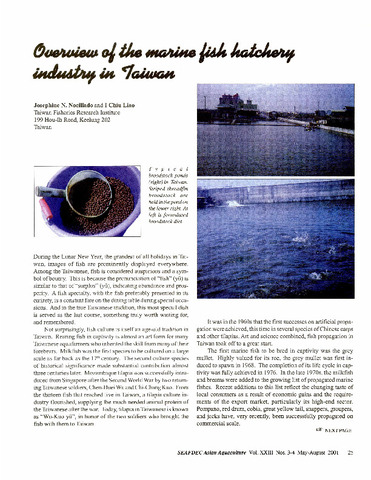Overview of the marine fish hatchery industry in Taiwan
| dc.contributor.author | Nocillado, Josephine N. | |
| dc.contributor.author | Liao, I Chiu | |
| dc.date.accessioned | 2013-11-28T06:07:59Z | |
| dc.date.available | 2013-11-28T06:07:59Z | |
| dc.date.issued | 2001 | |
| dc.identifier.citation | Nocillado, J. N., & Liao, I. C. (2001). Overview of the marine fish hatchery industry in taiwan. SEAFDEC Asian Aquaculture, 23(3-4), 25-27. | en |
| dc.identifier.issn | 0115-4974 | |
| dc.identifier.uri | http://hdl.handle.net/10862/1767 | |
| dc.description.abstract | Although fish culture itself is an age-old tradition in Taiwan, it was in the 1960s that the first successes on artificial propagation were achieved, with several species of Chinese carps and tilapias. The first marine fish to be bred in captivity was the grey mullet; it was first induced to spawn in 1968. Various other species have since been added to the list of propagated marine fish. The characteristics of the marine fish hatchery industry in Taiwan are outlined, considering both the outdoor pond and indoor tank systems. Future prospects are very good; Taiwan now exports marine fish larvae and fingerlings to many of its Asian neighbours and there are some 60 marine fish species for which commercial larval production is possible. | en |
| dc.language.iso | en | en |
| dc.publisher | Aquaculture Department, Southeast Asian Fisheries Development Center | en |
| dc.subject | Taiwan Province of China | en |
| dc.title | Overview of the marine fish hatchery industry in Taiwan | en |
| dc.type | magazineArticle | en |
| dc.citation.volume | 23 | |
| dc.citation.issue | 3-4 | |
| dc.citation.spage | 25 | |
| dc.citation.epage | 27 | |
| dc.citation.journalTitle | SEAFDEC Asian Aquaculture | en |
| dc.subject.asfa | mariculture | en |
| dc.subject.asfa | fish culture | en |
| dc.subject.asfa | aquaculture systems | en |
| dc.subject.asfa | aquaculture development | en |
| dc.subject.asfa | hatcheries | en |


